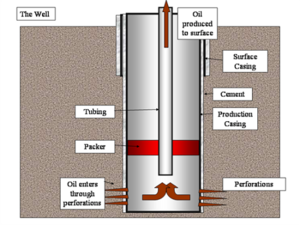Gulf of Mexico oil spillBP's cost-cutting approach made well vulnerable, left company unprepared
Safety upgrades are critical but could mean higher prices for oil and gas; to cut costs, BP decided to install a continuous set of threaded casing pipes from the wellhead down to the bottom of its well; this leaves one blind to leaks that sneak up around the casing pipe, and the long string gives gas more time to percolate into the well; a preferred — and costlier — alternative in high-pressure deepwater is a “liner” design in which drillers install and then cement in place a short string of casing in the lower reaches of the well before casing the rest of the well

Schematic showing the use of cement with casing pipe // Source: blogspot.com
A culture of tighter safety and more experienced regulators might have prevented the BP Deepwater Horizon leak. Equipment modifications and new technology, however, will be needed to minimize the risk of such deepwater oil leaks. According to some petroleum engineers, recommended technology upgrades could price some deepwater resources out of the global energy market.
This could help extend the six-month moratorium on deepwater drilling instituted by President Obama last month. “I tend to be kind of a glass half empty guy, but I think there’s a 50/50 chance that the current six-month moratorium will stretch out,” says Paul Bommer, a senior lecturer in petroleum engineering at the University of Texas at Austin.
Peter Fairley writes in Technology Review that documents and statements released by various federal investigators point to several decisions and at least one faulty piece of equipment that allowed uncontrolled gas and crude to blow out and destroy the Deepwater Horizon rig on 20 April, initiating the worst oil spill in U.S. history.
Engineers contacted by Technology Review insist that conclusive answers will come with completion of the investigations, but criticize, for example, BP’s decision to install a continuous set of threaded casing pipes from the wellhead down to the bottom of its well. “The only thing I can figure is they must have thought it was a cost-cutting deal,” says Bommer of BP’s well design.
This can be problematic in deep, high-pressure wells for two reasons. First, it seals off the space between the casing and the bore hole, leaving one blind to leaks that sneak up around the casing pipe (as the BP Deepwater blowout is suspected to have done). Second, the long string gives gas more time to percolate into the well. A preferred alternative in high-pressure deepwater is a “liner” design in which drillers install and then cement in place a short string of casing in the lower reaches of the well before casing the rest of the well. This design enables the driller to watch for leaks while the cement is setting. “It takes a more time and costs a little more but it’s a much safer way to do it,” says Geoff Kimbrough, vice president for deepwater operations at Houston-based drilling consultancy New Tech Engineering.
Kimbrough cautions that transforming corporate cultures will take time because choosing the more conservative operation can easily cost $10 million to $20 million. Not all companies have leaders
